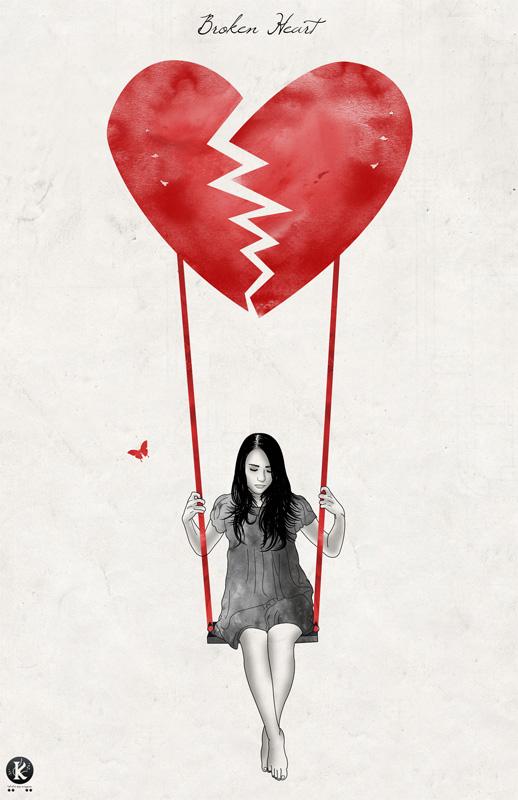Syndrome du coeur brisé
Il est un sujet qui divise particulièrement l’être humain lorsqu’il s’agit de choisir entre le coeur et le cerveau. Pourtant dans un monde ou la logique et le rationnel s’imposent comme niveau d’indépendance élevé et où les stratégies réfléchies laissent peu de place aux sentiments nous sommes devenus des spécialistes de la réflexion au détriment de notre ressenti. Penser est plus important que ressentir ? Avoir des émotions est loin d’être considéré comme une faiblesse à mon sens. C’est certainement un signe prononcé de créativité. Et après tout l’amour vient bien du coeur et non du cerveau.
Connaissez-vous le syndrome du coeur brisé aussi appelé la cardiomyopathie du Tako-Tsubo ? A en croire la recherche médicale, ce syndrome n’a été décrit pour la première fois que dans les années 90 par des cardiologues japonais. Tako-Tsubo est le nom d’un pot de céramique utilisé par les pêcheurs japonais pour piéger les poulpes (cet animal appelée également pieuvre qui possède 8 tentacules, 3 coeurs et 9 cerveaux). La cardiopathie se caractérise au niveau du ventricule gauche qui, dans une phase aiguë, gonfle évoquant un piège à poulpe coincé à l’intérieur d’un pot.
Vous ne trouvez pas curieux que la médecine, qui n’est certainement pas le lieu où les notions de sentiments et d’amour s’expriment le mieux, utilise cette analyse dans une approche systémique pour apporter une explication à ce phénomène. Sommes-nous là dans le coeur ou le cerveau ?
Le coeur brisé (ou chagrin d’amour) est une métaphore qui exprime l’émotion intense d’une douleur ou d’un stress que quelqu’un ressent quand il éprouve un grand désir. La littérature multi-culturelle cite de nombreux amants désirés ou perdus depuis l’Antiquité.
Peut-on choisir entre le coeur et le cerveau ?
Sans coeur nous sommes perdus. Quel sens donner à nos vies ?
Exercice : Connectez votre coeur à votre cerveau.
Assis ou allongé confortablement, portez votre attention à la qualité de votre respiration. Inspirez par le nez, souffler par le nez, en marquant une pause entre chaque inspiration/expiration. Après une dizaine de répétitions, doubler la durée de votre expiration par rapport à votre inspiration en effectuant un souffle léger, continu et sans variation tout en écoutant les battements de votre coeur.
Continuez en visualisant chaque battement comme des pas qui vous rapprochent de votre coeur. Imaginez que vous reconnecter cette relation pour regagner votre coeur et le succès dans votre vie. Chaque pas effectué est accompli avec la volonté de modifier et libérer la tristesse contenu dans votre perception. Vous remplacez cette dominante par ce qui est important pour vous. Laissez votre coeur vous guider vers ce chemin, il sait ce qui a de l’importance pour vous. Une fois que vous savez cela, alors votre esprit vous aidera dans l’accomplissement. Dès que ces deux éléments sont alignés alors vous serez inarrêtable et performant. En continuant votre respiration, visualisez ces éléments s’aligner et l’énergie qui se déploie. Lorsque vous souhaitez sortir de cet exercice, commencez à bouger lentement vos doigts et ouvrez vos yeux.
Broken heart syndrome
There is a subject that particularly divides human beings when it comes to choosing between the heart and the brain. Yet in a world where logic and rationality are imposed as a high level of independence and where thoughtful strategies leave little room for feelings, we have become specialists in thinking at the expense of our feelings. Thinking is more important than feeling? Having emotions is far from being considered a weakness in my opinion. This is certainly a strong sign of creativity. And after all, love blows from the heart and not from the brain.
Are you familiar with broken heart syndrome, also known as Tako-Tsubo cardiomyopathy? According to medical research, this syndrome was first described in the 1990s by Japanese cardiologists. Tako-Tsubo is the name of a ceramic pot used by Japanese fishermen to trap octopuses (this animal has 8 tentacles, 3 hearts and 9 brains). The cardiopathy is characterized by the left ventricle which, in an acute phase, swells like an octopus trapped inside a pot.
You do not find it curious that medicine, which is certainly not the place where the notions of feelings and love are best expressed, should use this analysis in a systemic approach to provide an explanation for this phenomenon. Are we here in the heart or the brain?
The broken heart (or heartache) is a metaphor that expresses the intense emotion of pain or stress that someone feels when they have a strong desire. Multi-cultural literature cites many lovers who have been desired or lost since ancient times.
Can we choose between the heart and the brain?
Without a heart we are lost. What meaning should we give to our lives?
Exercise: Connect your heart to your brain.
Sitting or lying comfortably, pay attention to the quality of your breathing. Breathe in through the nose, breathe out through the nose, pausing between each breath in/out. After ten repetitions, double the duration of your exhalation from your inspiration by making a light, continuous and unchanging breath while listening to the beats of your heart.
Continue by visualizing each beat as steps that bring you closer to your heart. Imagine that you reconnect this relationship to regain your heart and success in your life. Each step taken is accomplished with the will to modify and release the sadness contained in your perception. You replace this dominant by what is important to you. Let your heart guide you along this path, it knows what is important to you. Once you know this, then your mind will help you in accomplishing it. As soon as these two elements are aligned then you will be unstoppable and efficient. As you continue breathing, visualize these elements align and the energy unfolds. When you want to get out of this exercise, start moving your fingers slowly and open your eyes.
